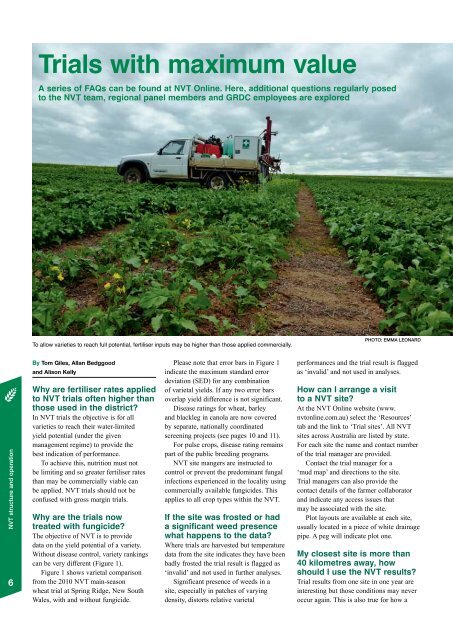NatioNal variety trials supplemeNt - Grains Research ...
NatioNal variety trials supplemeNt - Grains Research ...
NatioNal variety trials supplemeNt - Grains Research ...
Create successful ePaper yourself
Turn your PDF publications into a flip-book with our unique Google optimized e-Paper software.
Trials with maximum value<br />
A series of FAQs can be found at NVT Online. Here, additional questions regularly posed<br />
to the NVT team, regional panel members and GRDC employees are explored<br />
To allow varieties to reach full potential, fertiliser inputs may be higher than those applied commercially.<br />
photo: Emma Leonard<br />
NVT structure and operation<br />
6<br />
By Tom Giles, Allan Bedggood<br />
and Alison Kelly<br />
Why are fertiliser rates applied<br />
to NVT <strong>trials</strong> often higher than<br />
those used in the district<br />
In NVT <strong>trials</strong> the objective is for all<br />
varieties to reach their water-limited<br />
yield potential (under the given<br />
management regime) to provide the<br />
best indication of performance.<br />
To achieve this, nutrition must not<br />
be limiting and so greater fertiliser rates<br />
than may be commercially viable can<br />
be applied. NVT <strong>trials</strong> should not be<br />
confused with gross margin <strong>trials</strong>.<br />
Why are the <strong>trials</strong> now<br />
treated with fungicide<br />
The objective of NVT is to provide<br />
data on the yield potential of a <strong>variety</strong>.<br />
Without disease control, <strong>variety</strong> rankings<br />
can be very different (Figure 1).<br />
Figure 1 shows varietal comparison<br />
from the 2010 NVT main-season<br />
wheat trial at Spring Ridge, New South<br />
Wales, with and without fungicide.<br />
Please note that error bars in Figure 1<br />
indicate the maximum standard error<br />
deviation (SED) for any combination<br />
of varietal yields. If any two error bars<br />
overlap yield difference is not significant.<br />
Disease ratings for wheat, barley<br />
and blackleg in canola are now covered<br />
by separate, nationally coordinated<br />
screening projects (see pages 10 and 11).<br />
For pulse crops, disease rating remains<br />
part of the public breeding programs.<br />
NVT site mangers are instructed to<br />
control or prevent the predominant fungal<br />
infections experienced in the locality using<br />
commercially available fungicides. This<br />
applies to all crop types within the NVT.<br />
If the site was frosted or had<br />
a significant weed presence<br />
what happens to the data<br />
Where <strong>trials</strong> are harvested but temperature<br />
data from the site indicates they have been<br />
badly frosted the trial result is flagged as<br />
‘invalid’ and not used in further analyses.<br />
Significant presence of weeds in a<br />
site, especially in patches of varying<br />
density, distorts relative varietal<br />
performances and the trial result is flagged<br />
as ‘invalid’ and not used in analyses.<br />
How can I arrange a visit<br />
to a NVT site<br />
At the NVT Online website (www.<br />
nvtonline.com.au) select the ‘Resources’<br />
tab and the link to ‘Trial sites’. All NVT<br />
sites across Australia are listed by state.<br />
For each site the name and contact number<br />
of the trial manager are provided.<br />
Contact the trial manager for a<br />
‘mud map’ and directions to the site.<br />
Trial managers can also provide the<br />
contact details of the farmer collaborator<br />
and indicate any access issues that<br />
may be associated with the site.<br />
Plot layouts are available at each site,<br />
usually located in a piece of white drainage<br />
pipe. A peg will indicate plot one.<br />
My closest site is more than<br />
40 kilometres away, how<br />
should I use the NVT results<br />
Trial results from one site in one year are<br />
interesting but those conditions may never<br />
occur again. This is also true for how a

















